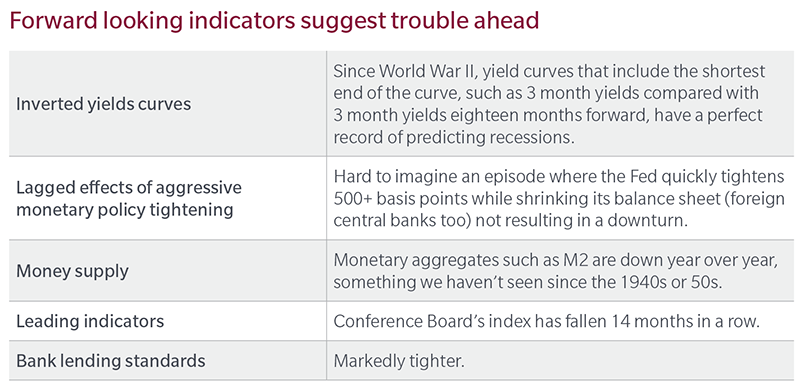by Erik S. Weisman, Chief Economist, Fixed Income Portfolio Manager, MFS Investment Management
MFS Chief Economist provides perspective on the current economy, central bank thinking, and the trajectory of a potential recessionary environment.
Amid the sharpest rise in inflation and interest rates in more than four decades, investors have been on recession watch for some time.
But lately, the data suggest — at a minimum — that the onset of a recession has been postponed. Recently we’ve seen upwardly revised US Q1 GDP, decent income generation, initial jobless claims coming off their recent peaks and better durable goods orders. Taken together, consumers appear to be plugging along. Looking at these numbers, you’d have no idea that we went through a mini-banking crisis just a few months ago given its minimal impact on the availability of credit.
However, forward-looking indicators are less rosy, so I still think the most likely scenario is that we will have a recession, though the timing remains murky.

So again, where’s the recession you ask?
While a recession doesn’t look imminent, monetary policy takes time to work its way through the economy. Think about businesses that sign contracts that last 12-,18- or 24-months. The Fed can raise rates an awful lot during those periods and not have an immediate impact on the economy. You might not feel the full impact of these hikes for 12 to 24 months — we’re in that window now.
Central banks rebuilding credibility
Central bankers are mindful that they lost credibility by sticking too long to a narrative that inflation was transitory, a result of pandemic-driven supply chain disruptions. Looking ahead, I’m concerned that they may overcompensate and remain more hawkish than expected.
With that in mind, it appears the persistent strength of the US labor market is incompatible with getting inflation back into its box. If the labor market is strong and income generation is robust, that allows the consumer to spend and should keep inflation higher than it would be otherwise, and that won’t get inflation where the Fed wants it to be. So it should be the case that you’ve got to weaken the labor market in order for the Fed to meet its inflation targets.
What remains to be seen is if the central bankers of today have the intestinal fortitude of 1980s Fed chair Paul Volcker. Are they willing to maintain rates at restrictive levels in the face of a sharp economic downturn if they think it is the only way to tame inflation? Or will they revert to the script of the past 30 years, easing policy at the first sign of trouble, perpetuating the so-called Fed put? We won’t know until or unless growth slows and inflation becomes stuck meaningfully above target.
At that point, central bankers will need to choose the policy error of least regret. Do they deepen a recession by maintaining restrictive policy or do they rekindle inflation by easing too soon?
Implications for markets
For market rates to fall materially, I think labor markets need to weaken, inflation needs to fall more quickly and the Fed needs to signal that its done hiking. Notwithstanding the promising inflation and employment readings in June, I think the Fed needs to see several months of similar data before it’s willing to signal that the tightening cycle has come to an end.
The views expressed are those of the author(s) and are subject to change at any time. These views are for informational purposes only and should not be relied upon as a recommendation to purchase any security or as a solicitation or investment advice. No forecasts can be guaranteed.
Copyright © MFS Investment Management















